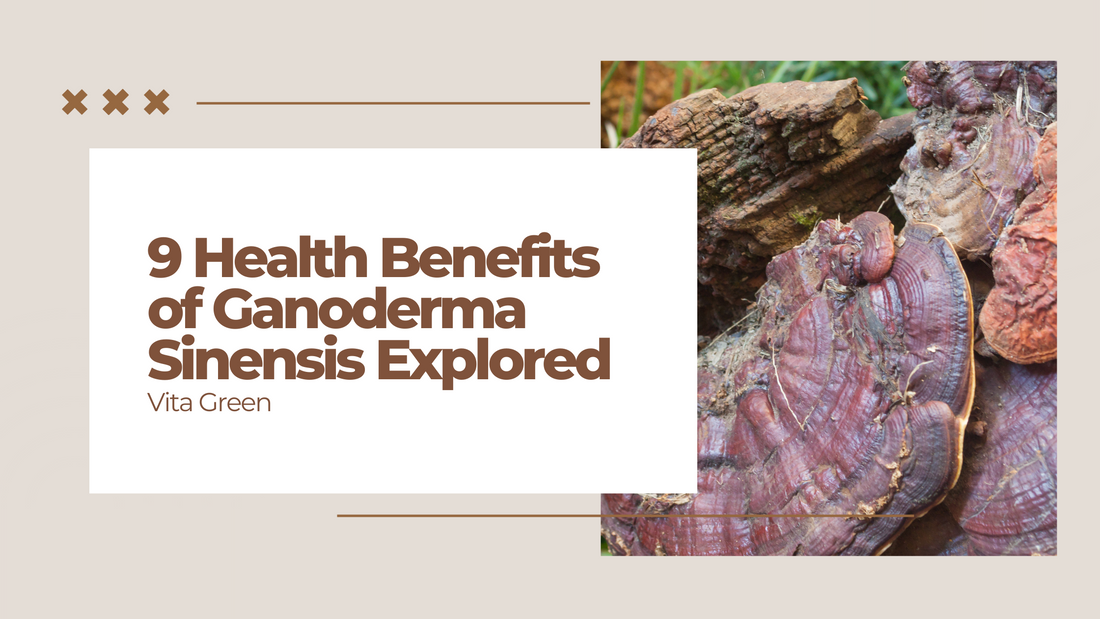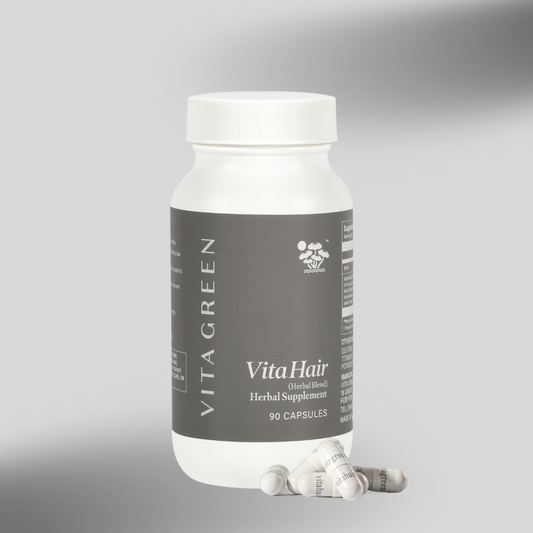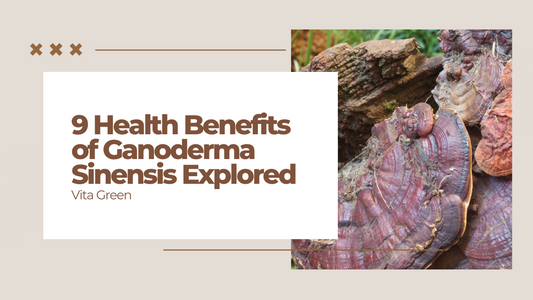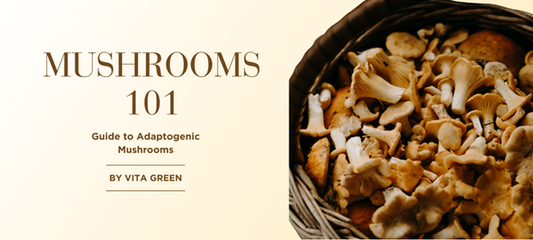By Frances Fajardo
Well-recognized for its notable medicinal properties, Ganoderma Sinensis, commonly referred to as Purple Reishi, has been gaining traction in the holistic health and wellness domain. Here, we explore nine significant reasons why Ganoderma Sinensis holds significance in both traditional and modern medicinal practices.
1. Immune Support
Purple Reishi, also known as Ganoderma Sinensis, shares a fundamental characteristic with its more renowned counterpart, Red Reishi: its ability to bolster the immune system. This immune-supporting property arises from the presence of various bioactive compounds within Purple Reishi. These compounds, including polysaccharides, triterpenoids, and other immunomodulating agents, play a pivotal role in enhancing the body's defense mechanisms against infections and illnesses.

Polysaccharides found in Purple Reishi, such as beta-glucans, are particularly noteworthy for their immunostimulatory effects. They stimulate immune cells like macrophages, T cells, and natural killer cells, amplifying their activity and improving their ability to identify and eliminate pathogens. This heightened immune response not only aids in fighting off infections but also contributes to overall immune system balance and resilience.

Moreover, Purple Reishi contains triterpenoids, which possess anti-inflammatory properties that can further support immune function. By reducing inflammation, these compounds help prevent excessive immune responses that may lead to tissue damage or autoimmune conditions. This dual action of immune stimulation and inflammation modulation underscores Purple Reishi's role as a valuable ally in fortifying the body's natural defenses.
2. Anti-inflammatory Properties
Purple Reishi, renowned for its therapeutic potential, harbors a notable attribute: its profound anti-inflammatory properties. Embedded within this remarkable fungus are bioactive compounds that actively combat inflammation, offering relief from a spectrum of inflammatory conditions that afflict the body.

At the core of Purple Reishi's anti-inflammatory prowess lie its polysaccharides and triterpenoids, which work synergistically to mitigate inflammatory processes within the body. Polysaccharides, serve as potent immunomodulators that not only bolster the immune response but also exert anti-inflammatory effects. These compounds inhibit the production of pro-inflammatory cytokines and enzymes, thereby curbing the inflammatory cascade and dampening excessive immune responses.
Triterpenoids found in Purple Reishi contribute further to its anti-inflammatory arsenal. These bioactive compounds target key pathways involved in inflammation, such as the NF-κB pathway, which regulates the expression of pro-inflammatory genes. By modulating these pathways, triterpenoids help attenuate the inflammatory response, alleviating symptoms associated with inflammatory conditions such as arthritis, asthma, and inflammatory bowel disease.

The anti-inflammatory properties of Purple Reishi extend beyond mere symptom management; they offer a holistic approach to addressing the underlying mechanisms driving chronic inflammation. By quelling inflammation at its source, Purple Reishi not only provides relief from discomfort but also supports overall health and well-being.
3. Antioxidants
Within the intricate matrix of Purple Reishi lies a treasure trove of antioxidants, rendering it a potent guardian of cellular health and resilience. These antioxidants, including phenolic compounds, flavonoids, and polysaccharides, work harmoniously to combat oxidative stress, a process implicated in the onset and progression of numerous chronic diseases.

Oxidative stress occurs when the balance between free radicals and antioxidants in the body is disrupted, resulting in cellular damage and dysfunction. Free radicals, unstable molecules generated during normal metabolic processes or in response to external stressors like pollution and UV radiation, wreak havoc on cellular structures, including DNA, proteins, and lipids. Left unchecked, this oxidative damage can contribute to the development of chronic conditions such as cardiovascular disease, cancer, and neurodegenerative disorders.

Purple Reishi emerges as a formidable ally in the battle against oxidative stress, thanks to its rich antioxidant content. Phenolic compounds and flavonoids, both present abundantly in Purple Reishi, scavenge free radicals -neutralizing their harmful effects and preventing them from inflicting damage on cellular components. Moreover, polysaccharides found in Purple Reishi exhibit antioxidant activity, further bolstering its protective capabilities against oxidative stress-induced injury.
By quenching free radicals and bolstering the body's antioxidant defenses, Purple Reishi helps fortify cellular integrity and function. This fortification not only mitigates the risk of chronic diseases but also promotes overall health and vitality. Incorporating Purple Reishi into one's daily regimen, whether through dietary supplements or culinary preparations, provides a natural and effective means of harnessing the antioxidant power of this remarkable fungus.
4. Stress Relief
In today's fast-paced world, stress and anxiety have become pervasive challenges that can significantly impact overall well-being. Fortunately, Purple Reishi offers a natural solution, with emerging evidence suggesting its potential to alleviate stress and promote a sense of calm and relaxation.

At the heart of Purple Reishi's stress-relieving properties lie its bioactive compounds that interact with the body's stress response system, modulating hormone levels and neurotransmitter activity to promote balance and resilience in the face of stressors.
One key mechanism through which Purple Reishi exerts its stress-reducing effects is by regulating the hypothalamic-pituitary-adrenal (HPA) axis, a complex network involved in the body's response to stress. By modulating the release of stress hormones such as cortisol and adrenaline, Purple Reishi helps mitigate the physiological effects of stress, such as elevated heart rate and blood pressure.

Moreover, Purple Reishi contains adaptogenic compounds that enhance the body's ability to cope with stressors, whether physical, mental, or environmental in nature. These adaptogens promote homeostasis within the body, helping to buffer against the negative effects of stress and restore equilibrium.
In addition to its direct effects on stress physiology, Purple Reishi also influences neurotransmitter activity in the brain, particularly serotonin and gamma-aminobutyric acid (GABA). By enhancing serotonin levels and modulating GABA receptor activity, Purple Reishi promotes feelings of relaxation and tranquility, counteracting the symptoms of anxiety and promoting a sense of well-being.
5. Liver Support
The liver plays a central role in maintaining overall health by performing vital functions such as detoxification, metabolism, and nutrient storage. Given its critical functions, supporting liver health is essential for optimal well-being. Emerging research suggests that Purple Reishi possesses hepatoprotective properties, making it a promising ally in promoting liver health and function.

Studies investigating the effects of Purple Reishi on liver health have highlighted its potential to exert hepatoprotective effects through various mechanisms. One key mechanism involves its antioxidant properties, which help neutralize harmful free radicals and reduce oxidative stress in the liver. By scavenging free radicals and preventing oxidative damage to liver cells, Purple Reishi helps protect against liver injury and dysfunction.
Furthermore, Purple Reishi contains bioactive compounds such as triterpenoids and polysaccharides that exhibit anti-inflammatory properties. Chronic inflammation is a common underlying factor in liver diseases such as fatty liver disease, hepatitis, and cirrhosis. Purple Reishi's anti-inflammatory effects may help alleviate inflammation in the liver, thereby reducing the risk of liver damage and promoting overall liver health.

Moreover, Purple Reishi has been found to modulate liver enzyme activity and enhance liver function. Studies have reported improvements in liver enzyme levels, indicating enhanced liver metabolism and detoxification processes. By optimizing liver function, Purple Reishi supports the body's ability to eliminate toxins and metabolic waste products, promoting systemic detoxification and metabolic balance.
Additionally, Purple Reishi may support liver regeneration and repair mechanisms, helping to restore damaged liver tissue and maintain liver health over time. These regenerative properties are particularly beneficial for individuals with liver diseases or those at risk of liver damage due to factors such as alcohol consumption, medication use, or exposure to environmental toxins.
6. Heart Health
The cardiovascular system, comprising the heart and blood vessels, is integral to overall health, circulating oxygen and nutrients throughout the body. Maintaining cardiovascular health is important for preventing heart disease and related conditions. Recent research suggests that Purple Reishi holds promise in supporting heart health, with potential benefits including the reduction of blood pressure and cholesterol levels.

Studies investigating the cardiovascular effects of Purple Reishi have revealed its ability to modulate various risk factors associated with heart disease. One notable benefit is its potential to lower blood pressure. Hypertension, or high blood pressure, is a significant risk factor for cardiovascular disease. Purple Reishi contains bioactive compounds that exert vasodilatory effects, relaxing blood vessels and promoting improved blood flow. By reducing vascular resistance, Purple Reishi may help lower blood pressure levels, thereby mitigating the risk of hypertension-related complications.
Furthermore, Purple Reishi has shown promise in improving lipid profiles by lowering cholesterol levels. High cholesterol, particularly elevated levels of LDL (low-density lipoprotein) cholesterol, is a key contributor to atherosclerosis and coronary artery disease. Purple Reishi contains compounds that inhibit cholesterol synthesis and absorption in the intestines, leading to decreased LDL cholesterol levels and a more favorable lipid profile. Additionally, Purple Reishi's antioxidant properties help prevent the oxidation of LDL cholesterol, which is a critical step in the development of atherosclerosis.

Moreover, Purple Reishi exhibits anti-inflammatory effects that may further benefit heart health. Chronic inflammation plays a central role in the development and progression of cardiovascular disease. By reducing inflammation within the arterial walls and throughout the body, Purple Reishi helps protect against atherosclerosis and vascular dysfunction, ultimately supporting overall cardiovascular function.
While further research is needed to fully elucidate the mechanisms underlying Purple Reishi's cardiovascular benefits, existing evidence suggests that it holds potential as a natural adjunctive therapy for promoting heart health.
7. Improved Sleep Quality
Sleep quality is essential for overall health and well-being, influencing various aspects of physical and mental functioning. Purple Reishi, with its long-standing history in traditional medicine, has garnered attention for its potential to improve sleep quality and address insomnia, offering individuals a natural remedy for achieving restful and rejuvenating sleep.

Traditionally, Purple Reishi has been revered for its adaptogenic properties, which help the body adapt to stressors and promote relaxation. By modulating stress hormone levels and calming the nervous system, Purple Reishi creates an optimal physiological state conducive to sleep initiation and maintenance. Its ability to induce a state of relaxation can ease the transition into sleep and reduce the occurrence of sleep disturbances throughout the night.
Furthermore, Purple Reishi contains bioactive compounds that interact with neurotransmitter systems involved in sleep regulation like serotonin and GABA. Serotonin plays a key role in mood regulation and sleep-wake cycles, while GABA acts as a neurotransmitter with calming effects on the brain. By enhancing the activity of these neurotransmitters, Purple Reishi promotes feelings of tranquility and promotes the onset of sleep.

Moreover, Purple Reishi's anti-inflammatory and antioxidant properties may indirectly support sleep quality by reducing inflammation and oxidative stress, both of which can interfere with sleep patterns. Chronic inflammation and oxidative damage have been linked to sleep disorders such as insomnia and sleep apnea. By addressing these underlying factors, Purple Reishi helps create a more favorable internal environment for restorative sleep.
8. Anti-aging Properties
As individuals age, they become increasingly susceptible to the cumulative effects of oxidative stress and inflammation, both of which play pivotal roles in the aging process and the development of age-related diseases. Purple Reishi emerges as a promising natural remedy with potential anti-aging properties, thanks to its rich antioxidant content and capacity to mitigate inflammation.

At the forefront of Purple Reishi's anti-aging arsenal are its potent antioxidants, which include polysaccharides, triterpenoids, and phenolic compounds. These antioxidants scavenge harmful free radicals, unstable molecules that contribute to oxidative damage to cells and tissues. By neutralizing free radicals, Purple Reishi helps protect cellular structures, including DNA, lipids, and proteins, from oxidative stress-induced damage. This preservation of cellular integrity not only mitigates the visible signs of aging, such as wrinkles and age spots but also supports overall health and longevity.
Furthermore, Purple Reishi's anti-inflammatory properties complement its antioxidant effects in the fight against aging. Chronic inflammation is a hallmark feature of aging and contributes to the development of age-related diseases, including cardiovascular disease, neurodegenerative disorders, and metabolic syndrome. Purple Reishi contains bioactive compounds that modulate inflammatory pathways, reducing the production of pro-inflammatory cytokines and mitigating tissue inflammation. By dampening chronic inflammation, Purple Reishi helps preserve tissue function and resilience, contributing to healthy aging and longevity.

Moreover, Purple Reishi's adaptogenic properties offer additional benefits for aging individuals. Adaptogens are substances that help the body adapt to stressors and maintain physiological balance, thereby supporting overall well-being. By regulating stress hormone levels and enhancing stress resilience, Purple Reishi helps mitigate the negative effects of stress on aging processes, promoting mental clarity, emotional stability, and vitality.
9. Mild Taste
In the realm of medicinal mushrooms, taste is often a crucial consideration for their incorporation into daily routines. Purple Reishi distinguishes itself from its counterparts, notably Red Reishi, through its milder flavor profile, rendering it more approachable for a broader spectrum of individuals.

While Red Reishi possesses a distinctive and sometimes intense earthy taste, Purple Reishi offers a gentler sensory experience. Its flavor is characterized by subtle notes that are less overpowering and more palatable, making it suitable for those who may find the robust taste of Red Reishi challenging to tolerate.
The lighter taste of Purple Reishi opens doors for diverse culinary applications and consumption methods. Whether brewed into a soothing tea, incorporated into savory dishes, or blended into smoothies and beverages, Purple Reishi seamlessly integrates into various recipes without overpowering other flavors. This versatility not only enhances its appeal but also encourages regular consumption, thereby maximizing its health benefits.

Furthermore, the mild taste of Purple Reishi lends itself well to incorporation into dietary supplements and functional foods, facilitating its integration into daily wellness routines. This accessibility ensures that individuals can reap the rewards of Purple Reishi's therapeutic properties without the aversion often associated with strongly flavored medicinal mushrooms.
Ultimately, the mild taste of Purple Reishi serves as a gateway for individuals seeking to harness the health-enhancing potential of medicinal mushrooms without compromising on flavor. Its subtle yet distinct profile makes it an inviting option for both seasoned enthusiasts and newcomers alike, fostering a more inclusive approach to holistic health and wellness practices.
But where does Ganoderma Sinensis gets its benefits?
Ganoderma Sinensis is esteemed for its rich array of bioactive compounds, each contributing to its remarkable medicinal properties.
Here's a closer look at some of the key compounds found in Ganoderma Sinensis:
Polysaccharides
Polysaccharides represent a cornerstone of the medicinal properties attributed to Ganoderma Sinensis. Abundant and extensively researched, these complex carbohydrates play a pivotal role in modulating the immune system, thus fortifying the body's defense mechanisms against a myriad of infections and diseases.

At the forefront of their immunomodulatory effects, polysaccharides orchestrate a multifaceted response within the immune system. They act as potent activators, stimulating key immune cells such as macrophages and T cells. Macrophages, the "first responders" of the immune system, engulf and digest foreign pathogens, while T cells orchestrate targeted attacks against infected or abnormal cells. By stimulating the activity of these immune cells, polysaccharides bolster the body's ability to recognize and eliminate threats, thus enhancing overall immune function.

Moreover, polysaccharides possess the remarkable ability to regulate immune responses, ensuring a finely tuned balance between activation and suppression. They help modulate the production of cytokines, signaling molecules that coordinate immune responses, thereby preventing excessive inflammation and autoimmune reactions. This immunoregulatory function is critical for maintaining immune homeostasis and preventing immune-related disorders.

Beyond their direct effects on immune cells, polysaccharides also exert indirect benefits on immune function. They promote the production of antibodies, specialized proteins that target specific pathogens for destruction, thereby enhancing the adaptive immune response. Additionally, polysaccharides enhance the activity of natural killer (NK) cells, which play a crucial role in detecting and eliminating virus-infected and cancerous cells.
Triterpenoids
Triterpenoids, a class of bioactive compounds abundantly present in Ganoderma Sinensis, play a pivotal role in endowing this medicinal mushroom with its remarkable therapeutic properties. Renowned for their diverse pharmacological effects, triterpenoids contribute significantly to Ganoderma Sinensis's anti-inflammatory, antioxidant, and hepatoprotective actions, making them indispensable allies in the quest for holistic health and well-being.

At the forefront of their pharmacological repertoire, triterpenoids exert potent anti-inflammatory effects, which are instrumental in alleviating inflammation-associated ailments. By inhibiting pro-inflammatory mediators and signaling pathways, triterpenoids mitigate the inflammatory cascade, thereby reducing pain, swelling, and tissue damage. This anti-inflammatory action holds promise for managing a spectrum of conditions characterized by chronic inflammation, including arthritis, asthma, and inflammatory bowel disease.
Furthermore, triterpenoids exhibit remarkable antioxidant activity, serving as scavengers of free radicals and other reactive oxygen species (ROS) that contribute to oxidative stress and cellular damage. By neutralizing free radicals, triterpenoids protect cells and tissues from oxidative injury, thereby mitigating the risk of various chronic diseases and age-related degenerative processes. This antioxidant prowess is particularly relevant in the context of cardiovascular health, neuroprotection, and skin rejuvenation.

Additionally, triterpenoids play a crucial role in supporting liver health and function, making them valuable assets in hepatoprotection. These compounds promote liver detoxification pathways, enhance bile secretion, and inhibit liver fibrosis and inflammation, thereby safeguarding against liver damage and dysfunction. Their hepatoprotective effects extend to mitigating the adverse effects of toxins, drugs, and metabolic imbalances, making them indispensable for maintaining liver health and vitality.
Peptides
Peptides found in Ganoderma Sinensis represent a class of biologically active molecules consisting of short chains of amino acids. These peptides play a crucial role in the therapeutic properties attributed to Ganoderma Sinensis, offering a diverse array of biological activities that contribute to its overall health benefits.

One of the primary roles of peptides in Ganoderma Sinensis is their antioxidant activity. These peptides scavenge harmful free radicals and other reactive oxygen species (ROS), thereby mitigating oxidative stress and reducing the risk of oxidative damage to cells and tissues. By neutralizing free radicals, peptides help protect against aging-related processes, inflammation, and chronic diseases associated with oxidative stress.

In addition to their antioxidant properties, peptides in Ganoderma Sinensis exhibit antimicrobial effects, making them valuable allies in combating infections and promoting immune health. These peptides have been shown to inhibit the growth of various pathogenic microorganisms, including bacteria, viruses, and fungi. By targeting microbial pathogens, peptides help strengthen the body's natural defenses and support overall immune function.
Furthermore, peptides in Ganoderma Sinensis possess anti-inflammatory properties, which play a crucial role in modulating immune responses and reducing inflammation. These peptides help regulate the production of pro-inflammatory cytokines and other mediators involved in inflammatory processes, thereby alleviating symptoms associated with inflammatory conditions such as arthritis, allergies, and autoimmune disorders.

The multifaceted biological activities of peptides in Ganoderma Sinensis contribute synergistically to its overall health benefits, making it a valuable therapeutic agent in traditional and complementary medicine. Incorporating Ganoderma Sinensis into one's wellness regimen, whether through dietary supplements, herbal teas, or skincare products, offers a natural and holistic approach to promoting health and vitality. By harnessing the diverse biological activities of peptides, Ganoderma Sinensis empowers individuals to enhance their well-being and support their body's innate healing mechanisms.
Ganoderic Acids
Ganoderic acids, exclusive to Ganoderma species including Ganoderma Sinensis, emerge as distinctive triterpenoid compounds renowned for their multifaceted medicinal properties. These bioactive constituents have garnered significant attention for their potential anti-tumor and cholesterol-lowering effects, as well as their broader impacts on immune function and inflammation modulation.

One of the most notable attributes of ganoderic acids is their potential anti-tumor activity. Research suggests that these compounds possess cytotoxic effects against various cancer cell lines, inhibiting tumor growth and inducing apoptosis (programmed cell death) in cancer cells. By targeting multiple pathways involved in cancer development and progression, ganoderic acids show promise as adjunctive therapies in cancer treatment regimens.
Also, ganoderic acids exhibit cholesterol-lowering effects, making them valuable allies in promoting cardiovascular health. These compounds have been shown to inhibit cholesterol synthesis in the liver and enhance the clearance of cholesterol from the bloodstream, thereby reducing circulating levels of LDL (low-density lipoprotein) cholesterol, often referred to as "bad" cholesterol. By lowering cholesterol levels, ganoderic acids help mitigate the risk of atherosclerosis and cardiovascular diseases.

In addition to their anti-tumor and cholesterol-lowering effects, ganoderic acids display potent anti-inflammatory properties. They modulate inflammatory pathways and suppress the production of pro-inflammatory mediators, thereby attenuating inflammation and alleviating symptoms associated with inflammatory conditions such as arthritis, asthma, and inflammatory bowel disease. This anti-inflammatory action contributes to the overall health benefits of Ganoderma Sinensis and supports its traditional use in managing various inflammatory ailments.
Adenosine
Adenosine, a purine nucleoside found within Ganoderma Sinensis, offers a myriad of therapeutic benefits owing to its diverse biological activities. As a potent vasodilator, adenosine plays a crucial role in promoting blood flow and circulation throughout the body, thereby supporting cardiovascular health and enhancing overall vitality.
One of the primary functions of adenosine is its ability to induce vasodilation, a process characterized by the relaxation and widening of blood vessels. By dilating blood vessels, adenosine facilitates the smooth flow of blood, ensuring adequate oxygen and nutrient delivery to tissues and organs. This enhanced circulation promotes cardiovascular health, lowers blood pressure, and reduces the risk of cardiovascular diseases such as hypertension and atherosclerosis.

Furthermore, adenosine exhibits anti-inflammatory properties, which contribute to its therapeutic potential in combating inflammatory conditions. Its anti-inflammatory effects also extend to the central nervous system, where adenosine modulates neuroinflammatory responses, offering neuroprotection and potentially reducing the risk of neurodegenerative diseases.

Moreover, adenosine may exert neuroprotective effects, safeguarding neurons from damage and promoting neuronal health and function. By modulating neurotransmitter release, synaptic transmission, and neuronal excitability, adenosine helps maintain synaptic plasticity and cognitive function. Its neuroprotective properties make it a promising candidate for the prevention and treatment of neurodegenerative disorders such as Alzheimer's disease and Parkinson's disease.
Ganodermanontriol
Ganodermanontriol, a bioactive compound found in Ganoderma Sinensis, has garnered significant attention for its potential therapeutic properties, particularly in the realm of cancer treatment and immune modulation. Extensive research has revealed promising findings regarding its multifaceted effects on health and well-being.
One of the most notable aspects of Ganodermanontriol is its potential anti-cancer activity. Studies have demonstrated that Ganodermanontriol exhibits inhibitory effects on tumor cell proliferation, effectively slowing down the growth and spread of cancer cells. Additionally, Ganodermanontriol has been shown to induce apoptosis, or programmed cell death, in cancer cells, thereby contributing to the suppression of tumor progression. These anti-cancer effects make Ganodermanontriol a promising candidate for adjunctive cancer therapy, complementing conventional treatments and potentially improving treatment outcomes.

Moreover, Ganodermanontriol displays potent anti-inflammatory properties, which are integral to its therapeutic potential. By modulating inflammatory pathways and reducing the production of pro-inflammatory mediators, Ganodermanontriol helps alleviate inflammation and associated symptoms.
In addition to its anti-cancer and anti-inflammatory effects, Ganodermanontriol exhibits immunomodulatory properties, enhancing the body's immune response and promoting immune system balance. By regulating immune cell function and cytokine production, Ganodermanontriol helps strengthen the immune system's ability to recognize and eliminate pathogens, while also modulating excessive immune responses that may contribute to autoimmune diseases.

The collective effects of Ganodermanontriol on cancer, inflammation, and immune function underscore its potential as a valuable therapeutic agent in the prevention and treatment of various diseases. Further research into its mechanisms of action and clinical applications is warranted to fully elucidate its therapeutic potential and optimize its use in medical practice.
Antioxidants
Antioxidants found abundantly in Ganoderma Sinensis constitute a fundamental aspect of its therapeutic profile, offering a multifaceted defense mechanism against oxidative stress and its associated health implications. Among these antioxidants, phenolic compounds and flavonoids stand out for their remarkable ability to neutralize free radicals and counteract the detrimental effects of oxidative damage.

The primary role of antioxidants in Ganoderma Sinensis is to scavenge free radicals, highly reactive molecules that can wreak havoc on cellular structures and biomolecules. Free radicals are generated as byproducts of metabolic processes or through exposure to environmental stressors such as UV radiation, pollution, and toxins. Left unchecked, free radicals can initiate chain reactions that lead to cellular damage, DNA mutations, and tissue inflammation, contributing to the pathogenesis of various chronic diseases and accelerating the aging process.
Phenolic compounds and flavonoids in Ganoderma Sinensis act as potent antioxidants, donating electrons to neutralize free radicals and prevent their harmful effects. By interrupting the chain reactions of oxidative stress, these antioxidants help protect cellular membranes, proteins, and nucleic acids from damage, thereby preserving cellular integrity and function. This cellular protection extends to vital organs and systems throughout the body, supporting cardiovascular health, neurological function, and immune resilience.

Moreover, antioxidants in Ganoderma Sinensis play a pivotal role in mitigating the effects of aging by combating oxidative stress-induced cellular senescence and promoting longevity. By reducing oxidative damage to tissues and organs, antioxidants help maintain physiological homeostasis and slow down the progression of age-related degenerative processes. Additionally, antioxidants may support healthy aging by promoting cellular repair mechanisms, enhancing mitochondrial function, and modulating gene expression pathways associated with longevity.

Incorporating Ganoderma Sinensis into one's daily regimen offers a natural and effective strategy for harnessing the antioxidant properties of phenolic compounds and flavonoids. Whether consumed as a dietary supplement, brewed as a tea, or integrated into skincare products, Ganoderma Sinensis provides a potent source of antioxidants that supports overall health, vitality, and longevity. By fortifying the body's defense systems against oxidative stress, antioxidants in Ganoderma Sinensis empower individuals to thrive and maintain optimal well-being throughout life.
With its diverse array of bioactive compounds, Ganoderma Sinensis stands as a holistic powerhouse for promoting health and well-being.
References:
- “The Different Colours of Reishi Mushroom”, Nov. 2022, https://www.inneratlas.com.au/blogs/journal/the-different-colours-of-reishi-mushroom#:~:text=Black%20Reishi%20is%20a%20member,soothe%20digestive%20discomfort%5B5%5D.
- Wachtel-Galor, Sissi. “Herbal Medicine: Biomolecular and Clinical Aspects. 2nd edition.”, 2011, https://www.ncbi.nlm.nih.gov/books/NBK92757/
- PhD Tinsley, Grant. “6 Benefits of Reishi Mushroom (Plus Side Effects and Dosage)”, Apr. 2023, https://www.healthline.com/nutrition/reishi-mushroom-benefits
- Akramiene, Dalia., et al. “Effects of beta-glucans on the immune system”, 2007, https://pubmed.ncbi.nlm.nih.gov/17895634/#:~:text=Beta%2Dglucans%20are%20naturally%20occurring,years%20in%20the%20Eastern%20countries.
- “What to Know About Pathogens”, May 2023, https://www.webmd.com/a-to-z-guides/what-to-know-about-pathogens
- MD, FACP Henochowicz, Stuart I. “Immune response”, Jan. 2022, https://medlineplus.gov/ency/article/000821.htm
- “Inflammation”, Mar. 2024, https://my.clevelandclinic.org/health/symptoms/21660-inflammation
- “What is the NF-κB pathway?”, Mechanobiology Institute, Nov. 2023, https://www.mbi.nus.edu.sg/mbinfo/what-is-the-nf-%CE%BAb-pathway/
- “What is inflammatory bowel disease (IBD)?”, Centers for Disease Control and Prevention, Apr. 2022, https://www.cdc.gov/ibd/what-is-IBD.htm#:~:text=What%20Is%20IBD%3F,damage%20to%20the%20GI%20tract.
- De la Rosa, Laura A., et al. “Phenolic Compounds”, 2019, https://www.sciencedirect.com/topics/food-science/phenolic-compound
- “free radical”, https://www.cancer.gov/publications/dictionaries/cancer-terms/def/free-radical
- Mellon, Isabel. “Transcription-Coupled DNA Repair, Overview”, 2004, https://www.sciencedirect.com/topics/materials-science/oxidative-damage
- Watson, Kathryn. “What Are Flavonoids? Everything You Need to Know”, Jul. 2023, https://www.healthline.com/health/what-are-flavonoids-everything-you-need-to-know
- “Understanding the stress response”, Harvard Health Publishing, Jul. 2020, https://www.health.harvard.edu/staying-healthy/understanding-the-stress-response
- Tresca, Amber J., “What Is the Hypothalamic-Pituitary-Adrenal (HPA) Axis?”, Jun. 2022, https://www.verywellhealth.com/hypothalamic-pituitary-adrenal-hpa-axis-5222557#:~:text=The%20hypothalamic%2Dpituitary%2Dadrenal%20(HPA)%20axis%20is%20a,system%20and%20the%20endocrine%20system.
- “Gamma-Aminobutyric Acid (GABA)”, Apr. 2022, https://my.clevelandclinic.org/health/articles/22857-gamma-aminobutyric-acid-gaba
- “The Liver and Its Functions”, Center for Liver Disease and Transplantation, https://columbiasurgery.org/liver/liver-and-its-functions#:~:text=The%20liver%20is%20the%20largest,in%20the%20right%20upper%20abdomen.
- “Liver disease”, Feb. 2024, https://www.mayoclinic.org/diseases-conditions/liver-problems/symptoms-causes/syc-20374502
- MD, MPH Kumar, Sonal. “Overview of Chronic Hepatitis”, Sep. 2022, https://www.msdmanuals.com/home/liver-and-gallbladder-disorders/hepatitis/overview-of-chronic-hepatitis#:~:text=Chronic%20hepatitis%20is%20inflammation%20of,C%20viruses%20and%20certain%20drugs.
- C J Burns, J M Boswell, and G W Olsen. “Liver enzyme activity and body mass index”, National Library of Medicine, PubMed, Dec. 1996, https://pubmed.ncbi.nlm.nih.gov/8978516/
- “liver: anatomy”, Mar. 2024, https://www.britannica.com/science/liver
- “Cardiovascular System”, Sept. 2021, https://my.clevelandclinic.org/health/body/21833-cardiovascular-system
- Davis, Julie. “High Cholesterol and High Blood Pressure”, Jul. 2023, https://www.webmd.com/cholesterol-management/high-cholesterol-and-high-blood-pressure
- Mayo Clinic Staff. “Vasodilators”, Aud. 2023, https://www.mayoclinic.org/diseases-conditions/high-blood-pressure/in-depth/high-blood-pressure-medication/art-20048154
- “LDL and HDL Cholesterol and Triglycerides”, May 2023, https://www.cdc.gov/cholesterol/ldl_hdl.htm#:~:text=LDL%20(low%2Ddensity%20lipoprotein),for%20heart%20disease%20and%20stroke.
- “Atherosclerosis”, https://www.hopkinsmedicine.org/health/conditions-and-diseases/atherosclerosis#:~:text=Atherosclerosis%20thickening%20or%20hardening%20of,walls%20become%20thickened%20and%20stiff.
- Daiber, Andreas., et al. “Targeting vascular (endothelial) dysfunction”, National Library of Medicine, PubMed Central, Jul. 2016, https://www.ncbi.nlm.nih.gov/pmc/articles/PMC5446575/#:~:text=Endothelial%20(vascular)%20dysfunction%20implies%20impaired,perfusion%20and%2For%20vascular%20tone.
- Suni, Eric and Dr. Rehman, Anis. “Insomnia”, Jan. 2024, https://www.sleepfoundation.org/insomnia
- Santos-Longhurst, Adrienne. “What Are the Symptoms and Causes of High Cortisol Levels?”, Jan. 2024, https://www.healthline.com/health/high-cortisol-symptoms
- McIntosh, James. “What is serotonin, and what does it do?”, Oct. 2023, https://www.medicalnewstoday.com/articles/232248
- MD, MBA, DFAPA Torres, Felix. “What are Sleep Disorders?”, American Psychiatric Association, Aug. 2020, https://www.psychiatry.org/patients-families/sleep-disorders/what-are-sleep-disorders
- Basaraba, Sharon. “Common Age-Related Diseases and Conditions”, Nov. 2022, https://www.verywellhealth.com/age-related-diseases-2223996
- World Health Organization. “Ageing and health”, Oct. 2022, https://www.who.int/news-room/fact-sheets/detail/ageing-and-health
- “4.1: Cell Structure and Function”, https://med.libretexts.org/Bookshelves/Anatomy_and_Physiology/Human_Anatomy_and_Physiology_Preparatory_Course_(Liachovitzky)/04%3A_Smallest_Level_of_Complexity_Alive-_Cells_Their_Structures_and_Functions/4.01%3A_Cell_Structure_and_Function
- Mayne, Katie., et al. “Aging and Neurodegenerative Disease: Is the Adaptive Immune System a Friend or Foe?”, Sept. 2020, https://www.frontiersin.org/articles/10.3389/fnagi.2020.572090/full
- Zhang, Kexin., et al. “Metabolic diseases and healthy aging: identifying environmental and behavioral risk factors and promoting public health”, National Library of Medicine, PubMed Central, Oct. 2023, https://www.ncbi.nlm.nih.gov/pmc/articles/PMC10603303/#:~:text=Aging%20as%20a%20risk%20factor,increased%20risk%20of%20metabolic%20disorders.
- “The Different Colours of Reishi Mushroom”, Nov. 2022, https://www.inneratlas.com.au/blogs/journal/the-different-colours-of-reishi-mushroom#:~:text=Purple%20Reishi%20~%20Ganoderma%20Sinensis&text=It%20has%20a%20lighter%20taste,the%20different%20types%20of%20Reishi!
- University of Bristol. “T cell macrophage interactions”, https://www.bristol.ac.uk/cellmolmed/air/ourresearch/project.tcell_mp.html#:~:text=Macrophages%20interact%20with%20T%20cells,that%20can%20kill%20surrounding%20cells.
- “Activation of Immune Response”, https://www.sciencedirect.com/topics/medicine-and-dentistry/activation-of-immune-response
- “Natural Killer Cells”, Apr. 2023, https://my.clevelandclinic.org/health/body/24898-natural-killer-cells
- “Polysaccharides”, https://byjus.com/biology/polysaccharides/
- Liu, Yue., et al. “Recent Advances in Antiviral Activities of Triterpenoids”, National Library of Medicine, PubMed Central, Oct. 2022, https://www.ncbi.nlm.nih.gov/pmc/articles/PMC9607549/
- Cicala, Carla and Morello, Silvana. “Signaling Pathways in Inflammation and Its Resolution: New Insights and Therapeutic Challenges”, National Library of Medicine, PubMed Central, Jul. 2023, https://www.ncbi.nlm.nih.gov/pmc/articles/PMC10341743/
- Juan, Celia Andres., et al. “The Chemistry of Reactive Oxygen Species (ROS) Revisited: Outlining Their Role in Biological Macromolecules (DNA, Lipids and Proteins) and Induced Pathologies”, Apr. 2021, https://www.mdpi.com/1422-0067/22/9/4642
- Xu, Guo-Bo., et al. “Hepatoprotective natural triterpenoids”, Feb. 2018, https://www.sciencedirect.com/science/article/abs/pii/S0223523418300114#:~:text=A%20number%20of%20natural%20triterpenoids,natural%20products%20for%20hepatoprotective%20agents.
- D. Brand, A.L. Orr, I.V. Perevoshchikova, and C.L. Quinlan. “The role of mitochondrial function and cellular bioenergetics in ageing and disease”, Jul. 2013, https://www.ncbi.nlm.nih.gov/pmc/articles/PMC4321783/#:~:text=The%20classic%20role%20of%20mitochondria,as%20growth%2C%20movement%20and%20homeostasis.
- Pear, Joseph J. “Physiological Homeostasis and Learning”, 2012, https://link.springer.com/referenceworkentry/10.1007/978-1-4419-1428-6_303#:~:text=Physiological%20homeostasis%20is%20the%20tendency,within%20specific%20ranges%20of%20values.
- “Genetic Mutations in Humans”, May 2022, https://my.clevelandclinic.org/health/body/23095-genetic-mutations-in-humans
- “Ultraviolet Radiation’, Aug. 2016, https://www.cdc.gov/nceh/radiation/ultraviolet.htm#:~:text=Ultraviolet%20(UV)%20radiation%20is%20a,however%2C%20overexposure%20may%20present%20risks.
- “Amino acids”, Jan. 2023, https://medlineplus.gov/ency/article/002222.htm
- Sreenica, Shishira and PhD King, Lori M. “Peptides: Types, Uses, and Benefits”, Feb. 2024, https://www.webmd.com/a-to-z-guides/what-are-peptides
- “Autoimmune disorders”, https://www.mountsinai.org/health-library/diseases-conditions/autoimmune-disorders
- “Ganoderic acid”, https://en.wikipedia.org/wiki/Ganoderic_acid
- Kolniak-Ostek, Joanna., et al. “Anticancer and Antioxidant Activities in Ganoderma lucidum Wild Mushrooms in Poland, as Well as Their Phenolic and Triterpenoid Compounds”, Aug. 2022, https://www.mdpi.com/1422-0067/23/16/9359#:~:text=Ganoderic%20acids%20are%20capable%20of,phenolic%20compounds%20in%20anticancer%20effects.
- Singh, Shashank and McKintosh Rebecca. “Adenosine”, Aug. 2023, https://www.ncbi.nlm.nih.gov/books/NBK519049/#:~:text=Adenosine%20is%20a%20purine%20nucleoside,receptors%20found%20throughout%20the%20body.
- Moore, Sarah. “What are the Types of Neuroinflammation?”, Feb 2020, https://www.news-medical.net/life-sciences/What-are-the-Types-of-Neuroinflammation.aspx
- “Brain Basics: The Life and Death of a Neuron”, https://www.ninds.nih.gov/health-information/public-education/brain-basics/brain-basics-life-and-death-neuron#:~:text=Neurons%20are%20nerve%20cells%20that,were%20ever%20going%20to%20have.
- The University of Queensland.“What is synaptic plasticity?”, https://qbi.uq.edu.au/brain-basics/brain/brain-physiology/what-synaptic-plasticity
- Centers for Disease Control and Prevention. “Alzheimer’s Disease and Related Dementias”, https://www.cdc.gov/aging/aginginfo/alzheimers.htm#:~:text=Alzheimer's%20disease%20is%20the%20most,thought%2C%20memory%2C%20and%20language.
- “Parkinson’s Disease: Causes, Symptoms, and Treatments”, Apr. 2022, https://www.nia.nih.gov/health/parkinsons-disease/parkinsons-disease-causes-symptoms-and-treatments#:~:text=Parkinson's%20disease%20is%20a%20brain,have%20difficulty%20walking%20and%20talking.
- “Ganodermanontriol”, https://pubchem.ncbi.nlm.nih.gov/compound/3001811
- RDN, LD Ware, Megan. “How can antioxidants benefit our health?”, Nov. 2023, https://www.medicalnewstoday.com/articles/301506







